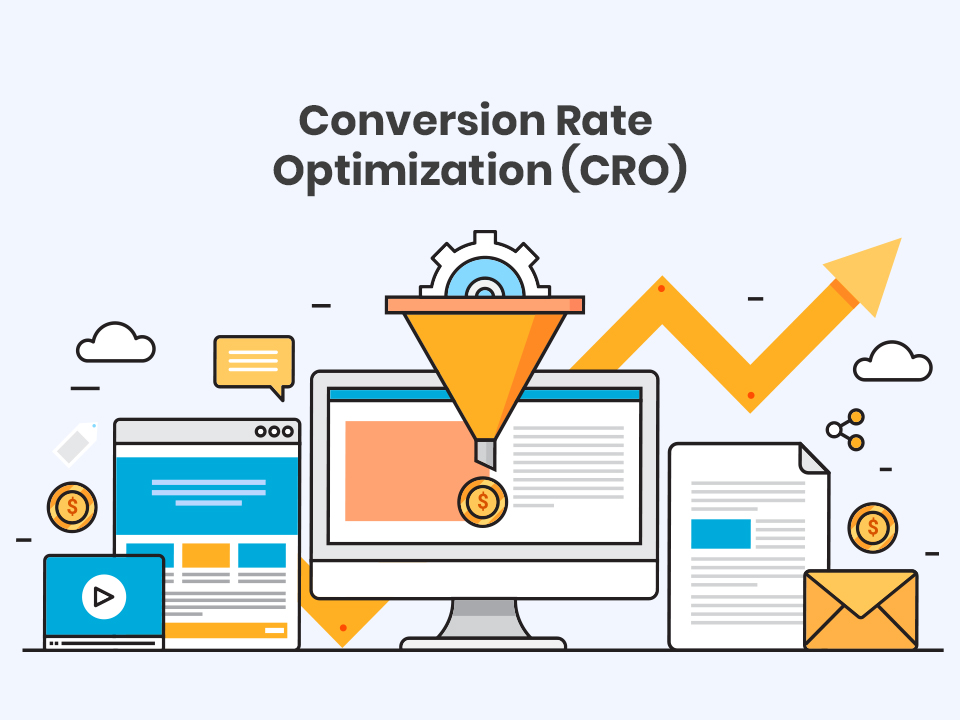Hello!
59 seconds. Research finds you have less than one minute to capture the users’ attention and convert them. The question is how to make the most of these 59 seconds. That’s when conversion rate optimization (CRO) comes into play.
Given below are five foolproof CRO best practices that our SaaS business has benefited from. And we are sure yours will too. Go through the list and grab conversion rate optimization hacks you can put to test today.
1. Start at the beginning - your website design
No matter how valuable your proposition is, the website design is still the most powerful means of catching the user’s attention. In SaaS world, first impressions really do count.
 • Offer a great web design
• Offer a great web design
What is the first thing that users see when they enter your website? Is it a crisp, modern eye candy? Or a 1990s-like clumpy monstrosity?
From the colors and fonts you choose to the smallest elements, like microinteractions and images, the website should reinforce your company’s brand. Every single dollar you invest in your website design will pay off in a big way.
When we first launched our website, it was rather minimalistic, to say the least. It had only one page with the sign up form. Later, we came up with our current design: with vivid colors, catchy copy, and unique illustrations. The website we have now perfectly represents our brand.
• Improve speed and performance
How fast your site loads is often a low hanging fruit in terms of conversion optimization. Yet, it is often overlooked.
 Research by TruConversion shows that increasing your page speed for at least one second can improve your conversions by up to 7%. What’s more, if your website takes more than 3 seconds to load, 40% of your visitors will simply leave the page even before they get to see what you have to offer.
Research by TruConversion shows that increasing your page speed for at least one second can improve your conversions by up to 7%. What’s more, if your website takes more than 3 seconds to load, 40% of your visitors will simply leave the page even before they get to see what you have to offer.
Improving your website performance is one of those CRO hacks that you don't want to overlook. One more thing: your website should work equally well on all devices and in all browsers (at least, the most popular ones).
2. Make them trust you
If you want people to buy from you, your website should be credible and inspire trust. Unless you are a well-known market leader, and your name speaks for itself. Yet, if you are reading this, the chances are you could use a bit of advice.
• Show why you're better than competition
 Searching for relevant keywords as a part of our content strategy, we found out that people were actually looking for alternatives to some of our major competitors. That was our aha moment. We learned how to drive organic traffic with high-intent keywords and were able to convert many of those leads as a result.
Searching for relevant keywords as a part of our content strategy, we found out that people were actually looking for alternatives to some of our major competitors. That was our aha moment. We learned how to drive organic traffic with high-intent keywords and were able to convert many of those leads as a result.
But optimizing your website for relevant keywords is only the tip of the iceberg. Once the visitors land on your website, you need to show them, how you differ from the solution they are currently using and why they should choose you instead.
In addition to writing a series of articles on the most popular team communication tools, we’ve crafted dedicated landing pages for each specific keyword. On these pages, we provide a concise, clear and fact-supported evidence of why our tool is better than the competitor.
• Leverage third-party endorsement
Show your potential customers that they are in a good company. You can use client testimonials, user feedback and ratings, awards or links to credible resources that wrote about you.
While our product was still in closed beta, we didn’t have any testimonials to list on the website. Generating and showcasing testimonials is one of my favorite CRO hacks and we recommend you to implement that strategy if you don't do it yet. So, we linked to several reputable resources, including SiliconRepublic, SEMrush, and CrazyEgg, that published our articles.
 Another important point is to let people easily reach you. If a company only has a “Contact Us” email form, it might raise doubts as to their fairness. It seems like they have something to hide.
Another important point is to let people easily reach you. If a company only has a “Contact Us” email form, it might raise doubts as to their fairness. It seems like they have something to hide.
On our website, we chose to add our physical address and email to the Privacy Policy page to show that we are there for our users if they need us.
In addition to that, we link to our pages on social media, which is also a good way to show that you are an established company. Having several hundred followers on your Facebook group won’t hurt either (we are also working on that).
3. Don’t hesitate to use pop-ups. Seriously
Pop-ups suck, right? Wrong!
It seems that people simply love to hate them. People complain about how annoying pop-ups are yet still they easily fall for a well-tailored message that appears in the right place at the right time. So, regardless of what they say, a good pop-up does its job perfectly. Here at Chanty, we learned from our own experience that pop-ups convert.
Our thorny path to a fullscreen exit pop-up
One of the most challenging tasks was to design a really effective exit pop-up, the message that is displayed to a user who is about to close the tab. Here are several draft examples we were considering at that time.
It is worth to mention that the copy accompanying your pop-up is as important as its visuals. A good practice is to make the negative option sound extremely unattractive compared to the clear benefit of signing up for your product.
As a result, this combo of a pop-up design and copy currently generates about 20% of all sign ups on our website.
Don’t forget about the ‘after sign up’ pop-up
 While a good exit pop-up can do magic to your conversions, there is one more way you can employ this handy tool. There is a chance to ask for one more favor before they leave.
While a good exit pop-up can do magic to your conversions, there is one more way you can employ this handy tool. There is a chance to ask for one more favor before they leave.
If your leads are ok providing their emails to you, the chances are they won’t mind sharing a link to your product with their friends online. If they liked you enough to sign up, their friends might find your product just as interesting.
A well-designed pop-up asking for a favor after they sign up can help you get some buzz online and generate more leads. This is why influencer marketing is currently on the rise. If the right person shares a note about your product with the right audience, the results might top all of your expectations.
4. Sign up forms here, there and everywhere
No matter how good your pop-up looks, there are more things to consider for a successful sign up process.
• Minimize the form fields
 Time is our most valuable resource. So, when you design your sign up form, make it as easy as possible to fill out. Otherwise, the leads can churn in the middle of the process frustrated with endless form fields.
Time is our most valuable resource. So, when you design your sign up form, make it as easy as possible to fill out. Otherwise, the leads can churn in the middle of the process frustrated with endless form fields.
First of all, set your priorities straight. Do you really need their company name, home address, phone number, and date of birth? If you ask for too much personal information, this might as well cause frustration and distrust.
We’ve chosen to ask only for an email from our customers. Of course, it’s up to you to decide what information you need. Yet, try to keep the number of fields to a minimum, when possible.
• Make your Call-to-Action (CTA) button visible
Even if your visitors closed the pop-up, this doesn’t mean you should give up on them. What if they decide to give your product a try after reading a couple of articles on your blog? You need to give them an option to sign up anytime. And it should be extremely easy. First, consider the placement and color of your CTA buttons.
In our case, we’ve decided to make the header on our blog fixed. As a result, the visitors can still clearly see the menu with a CTA as they scroll down and read the article. The green button also stands in contrast to the white blog background, making it even more noticeable.
 Yet, when reading the article, you won’t normally notice the menu or CTA. That is unless they catch your attention. To freshen up our CTA button, we’ve added a simple pulsating animation. As a result, we have a button that catches visitors’ attention, yet, isn’t too aggressive or annoying to scare them off.
Yet, when reading the article, you won’t normally notice the menu or CTA. That is unless they catch your attention. To freshen up our CTA button, we’ve added a simple pulsating animation. As a result, we have a button that catches visitors’ attention, yet, isn’t too aggressive or annoying to scare them off.
Now, the results speak for themselves. Since we implemented the changes (the end of October), the number of visitors who click on our CTA button grew twofold.
• Put different variations of sign up forms into test Conversion rate optimization is all about experiments and testing. You never know what will work until you try it. Just, like with the pop-ups, it never hurts to have several options to choose from.
Why rack your brains about your sign up form design, when you can ask your visitors to point out the option they like best? Well, not literally.
Simply create several design options and test them with your audience. The one that shows the best conversion rate is the winner!
5. Hook visitors with the content they fall in love with
While all of the listed hacks worked well for us, there is one tactic that is worth a special mention. In our case, the most successful CRO strategy was to focus on high-quality, valuable content the users will love to read and share.
 First of all, it is important to create the content with a purpose. Every piece of content you share should add value to the audience. Use your blog to educate your potential customers, entertain them, solve their problems.
First of all, it is important to create the content with a purpose. Every piece of content you share should add value to the audience. Use your blog to educate your potential customers, entertain them, solve their problems.
We at Chanty aim to become a go-to resource for team communication and collaboration. Be it a comparison of business chat apps or workplace efficiency tips in general, we got that covered.
In addition to accumulating expertise on our website, our team has been pretty active with guest blogging. We are constantly posting original content on a number of reputable resources in the field. Targeting a specific pain point, we drive high-intent traffic to our website. As a result, conversion from content marketing becomes pretty high.
So, how to use conversion rate optimization hacks to improve your startup?
While it might seem like sorcery to some, most of the winning CRO strategies turn out to be pretty straightforward. Make a clear statement. Offer value first. Show respect to your audience. Make it easy and intuitive for them to follow the required path to conversion.
Yet, as with many other aspects of a SaaS business, the devil is in the details. From the way your sign up button looks to the exact timing of your pop-up, there are many things that can either make or break your CRO strategy. Hopefully, our experience will help you avoid some of the mistakes.
- Digital Marketing: The Journey from Online Visitors to Loyal Customers
- SEO For Mortgage Brokers
- Catch a Free ChatGPT Alternative That Works Without Registration
Thank you!
Subscribe to our newsletter! Join us on social networks!
See you!






